The Early Years of the MMORPG Market in Brazil (2004–2010): The Golden Era of Level Up Games
How the MMORPG genre came to prominence in Brazil
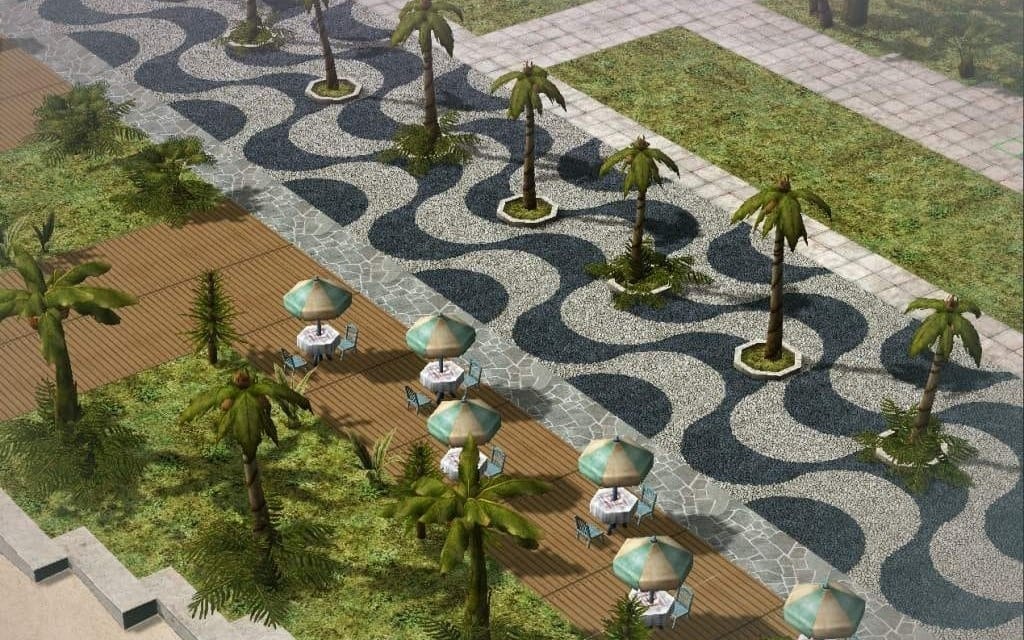
This story explores how the commercial MMORPG market began in Brazil. It highlights how online and free-to-play games have profoundly impacted culture and are an important part of the history of video games in Brazil.
After reading a recent essay by Felipe Pepe, I realized that the history of Level Up in Brazil may be a more relevant page in the history of video games than I imagined. That fact seems little known in the Global North, especially in the USA, so I decided to write this introductory story. First of all, it must be said that legendary MMORPGs like Ultima Online (1997) and EverQuest (1999) have always been almost unknown in Brazil, and World of Warcraft (2004) has always been much less known and played by us compared to some of Level Up's MMORPGs. Even though I was a fan of Warcraft III: Reign of Chaos (2002), The Frozen Throne (2003), and "DotA" (when it was a mod for Warcraft III), I never played World of Warcraft in the 2000s. World of Warcraft was only released in Brazil on December 6, 2011, and it took a while to become known in my country. The history of MMORPGs in Brazil was very different from that of the US and also had significant differences from other Latin American countries.
As is common for a PC gamer in the 1990s and 2000s, I loved RTS, FPS, and WRPG, especially Age of Mythology (2002), Call of Duty (2003), and Fable (2004). However, from 2004 onwards, I started playing MMORPGs from "Level Up! Inc" (later renamed "Level Up"), a Filipino game publishing studio founded in 2002 and owned by Asiasoft since 2014. Some of Level Up's games are among the ones I've played the most in my life, such as Ragnarök Online and Silkroad Online. Dofus, Grand Chase, GunZ: The Duel, Perfect World, and RuneScape all earned time on my monitor, and I got to know many others through friends who also played Level Up's games. I played other MMORPGs in the 2000s, such as Priston Tale, Mu Online, and Grand Fantasia Online, but this story is only about the games associated with the "Level Up! Games" trademark. Although Level Up is a company originating in the Philippines, it has Brazil as its core business, and it was in Brazil where it published most of its games.
Some games distributed by Level Up in Brazil:
- 9Dragons (BR: 2008), developed by Indy21
- Aion: The Tower of Eternity (BR: 2009), developed by NCSoft
- Allods Online (BR: 2010), developed by Allods Team
- Assault Fire ("Ni Zhan" in China) (BR: 2013), developed by Tencent
- City of Heroes (BR: 2006), developed by Cryptic Studios (formerly), Paragon Studios (formerly) and Homecoming Servers
- City of Villains (BR: 2006), developed by Paragon Studios
- Combat Arms (BR: 2010), developed by Nexon
- DarkEden (BR: 2008?), developed by SOFTON Entertainment
- Dofus (BR: 2008), developed by Ankama Games
- Eligium (BR: 2012), developed by Goldcool Games
- Elsword (BR: 2013), developed by KOG
- Forsaken (BR: 2012), developed by Perfect World Entertainment
- FunOrb (BR: 2009), a website dedicated to small, Java-based browser games
- Grand Chase (BR: 2006), developed by KOG Studios
- Guild Wars (BR: 2005), developed by ArenaNet
- GunZ: The Duel (BR: 2006), developed by MAIET Entertainment
- Khan Wars (BR: 2010), developed by XS Software
- Lineage II (BR: 2005), developed by NCSoft and E&G Studios
- Lunia (BR: 2008), developed by Allm
- MapleStory (BR: 2008), developed by Wizet
- M.A.R.S. (BR: 2012), developed by Yingpei Games Digital Technology
- Pangya (BR: 2005), developed by Ntreev Soft [The game was published by UNO, and was discontinued in 2007. From 2009 onwards, Level Up started distributing Pangya in Brazil.]
- Perfect World (BR: 2008), developed by Beijing Perfect World
- Ragnarök Online (BR: 2004), developed by Gravity
- RuneScape (BR: 2009), developed by Jagex
- Silkroad Online (BR: 2007), developed by Joymax
- SMITE (BR: 2014), developed by Titan Forge Games
- Sudden Attack (BR: 2011), developed by Nexon GT
- Trickster Online (BR: 2007), developed by Ntreev Soft
- Turma do Chico Bento (BR: 2012), developed by Insolita Studios
- Warface (BR: 2013), developed by Crytek Kiev, Blackwood Games (2019-2021)
- Warrior Epic (BR: 2009), developed by Possibility Space
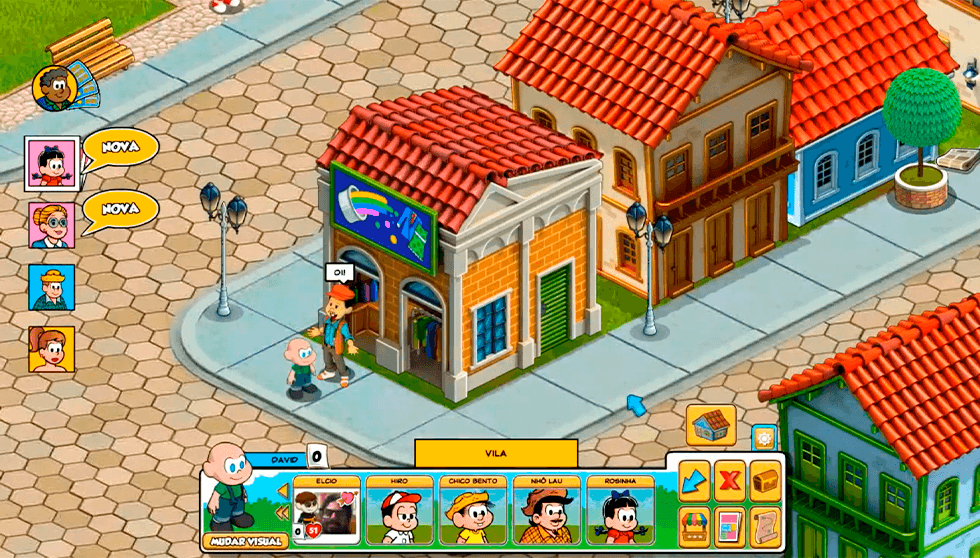
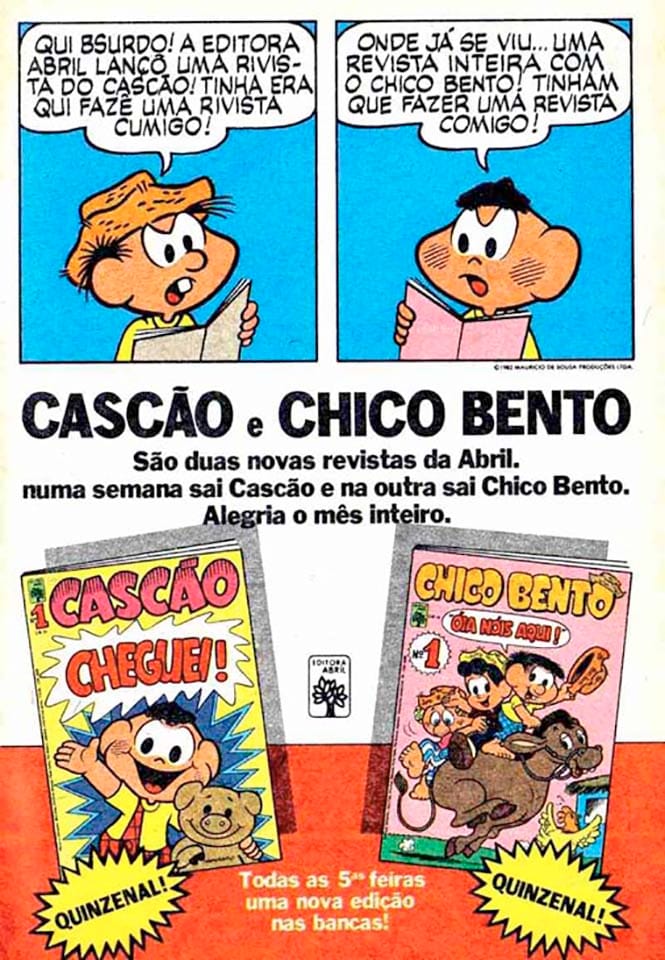
Left: Turma do Chico Bento (published by Level Up), a Brazilian farming simulation social network game based on Brazilian Chuck Billy 'n' Folks ("Turma do Chico Bento"), a Brazilian comic strip and part of the Monica's Gang ("Turma da Mônica") comic book series, created by Mauricio de Sousa; right: first advertisement for Chico Bento magazine, 1982. Sources: Webcore games; Arquivos Turma da Mônica.
In this story, I'll tell you a little about what it was like to be an MMORPG player in Brazil between 2004 and 2010, and I'll talk about some of the Level Up games I played in the 2000s. It doesn't mean that 2010 is the end of Level Up, but that year can be seen as a turning point. Since 2022, Level Up has changed its logo, launched a new website and a distribution platform (Hype), and expanded its business in Latin America. In Hispanic America, it is known as "Up n’ Beyond". Currently, Level Up operates as a publisher and in the content production business, producing podcasts, live streams, and e-sports competitions. Although this article is limited to the years 2004–2010, below is a brief chronology to give you a basic overview of the history of the company:
- 2004–2010: The Golden Era (Level Up Games' classic era)
- 2010–2016: The Renewal Era (period after Ragnarök Online Renewal update)
- 2016–2020: The Hype Era (Level Up launches a game distribution platform called "Hype")
- 2020–2022: The Pandemic Era
- 2022–now: The Level Up Latam Era


Left: reformulation of the "Level Up!" company in 2022; right: Level Up's office in São Paulo. Source: Level Up.
“We’ve been developing Hype for almost a year. We’re excited about the launch, but what motivates us most is seeing what’s next. Hype will be constantly evolving, always guided by what’s most important to the player. We want to make it easier for players to access PC and Mac games, both online and offline. We intend to do this by offering affordable prices, on an intuitive and secure platform."
Julio Vieitez, CEO of Level Up in October 2016 (IGN Brasil), one month before the launch of the Hype platform.
Table of Contents
I. The beginning of the PC MMORPG market in Brazil (2004–2010)
II. Game design and online experience in Level Up games
II. i. Classic MMORPG game design
II. ii. My top 5 online games published by Level Up
III. Final thoughts
I. The beginning of the PC MMORPG market in Brazil (2004–2010)
In the early 2000s, MMORPGs were very little known to Brazilians, but the success of the genre in the US inspired the Ignis Games studio (with 15 developers) to work for 3 years on the first Brazilian MMORPG, Erinia, published on May 5, 2004. According to Folha de São Paulo, the game could be played for free for 15 days, and then a monthly fee was required. The setting and enemies in this game are inspired by Tupi-Guaraní mythology and Brazilian folklore, including creatures like saci, caipora, o homem do saco, and many others (we will mention some more later). However, the project was a commercial failure, having reached a maximum of 600 simultaneous players. Erinia was too modest to compete with Ragnarök Online, which arrived in Brazil in the same year as the first international MMORPG translated into Portuguese.


Erinia. Source: Imagens das Antigas, Backloggd.
In September 2004, when Steam had only been around for a year, and its website was restricted to Valve games, Level Up began operating in Brazil in partnership with Tectoy, a Brazilian company best known for producing, publishing, and distributing Sega consoles and video games. Although better known in the console market, Tectoy also distributed PC games in Brazil such as Daytona USA (1994), Blade Runner (1997), and StarCraft (1998). Furthermore, Tectoy has been publishing Brazilian games for PC since the 1980s, such as Pense Bem (1988) and Show do Milhão (1999). The partnership between Tectoy and Level Up continued until the second half of 2010 when Tectoy sold its stake in Level Up. This partnership was important for Level Up because Tectoy knew the gaming market in Brazil and the social and economic context of the country in the 2000s like no other company. Interestingly, Level Up had a website where it was possible not only to buy CASH for its games but also to give credits to buy games for Zeebo, a Brazilian console released by Tectoy in 2009.
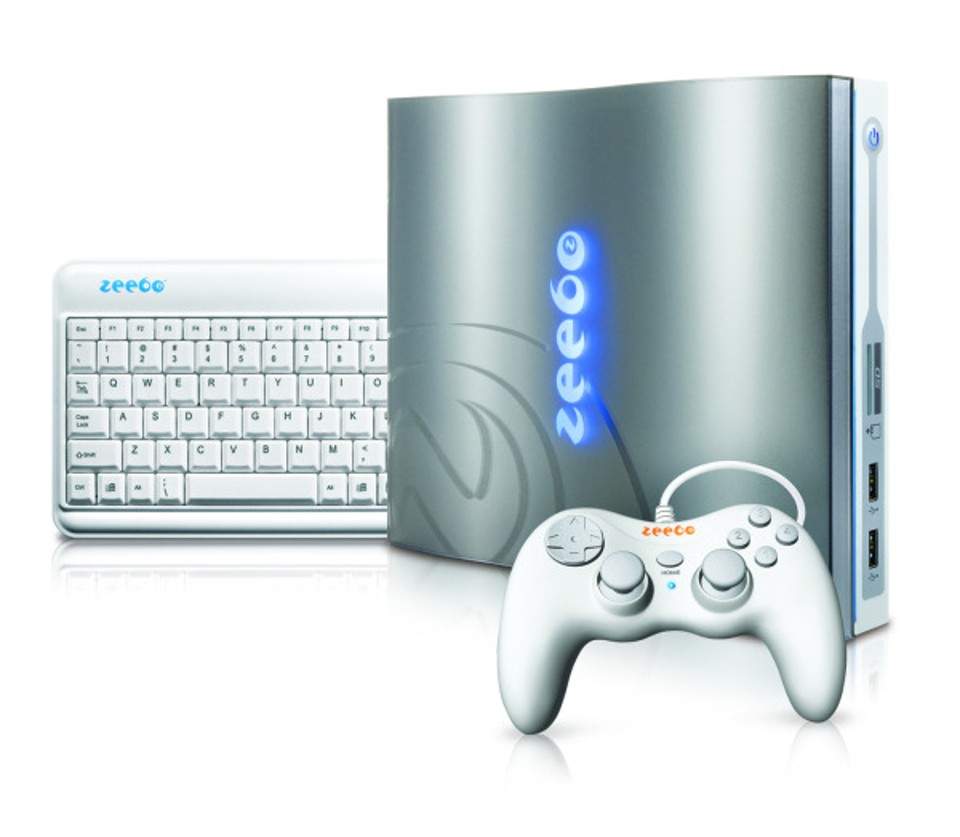
Let's take a brief economic overview. After restoring its democracy in the 1980s, and after overcoming one of the worst inflationary crises in history in the 1990s, Brazil in the 2000s was in the "Lula Era", its most prosperous economic period in three decades. During his two terms, President Lula undertook radical reforms and changes that tripled the country's GDP per capita, leading it to achieve investment-grade status by the Standard & Poor's credit rating agency. The peak of economic growth in the decade was in 2010 when Brazil's GDP grew by 7.5% (the third highest growth of any country in that year). However, Brazil was and continues to be a middle-income country; that is, a country with a per capita income between US$1,136 and US$13,845. In 2004, when Level Up came to Brazil, the country had the 37th highest per capita income (Folha de São Paulo, March 31, 2005).
According to World Integrated Trade Solution (WITS), from 2004 to 2010, Brazil's GDP per capita (constant 2010 US$) rose from US$7,178.35 to US$8,673.90. In addition to GDP per capita, inequality in Brazil must be taken into account. In 2004, in a ranking of 127 countries, Brazil was the eighth most unequal country in the ranking, with a Gini coefficient of 0.591 (this is the index that compares the income of the richest 20% with that of the poorest 20%). Between 2004 and 2009, inequality according to the Gini coefficient decreased by 5.6%, and average real income increased by 28%, but even today Brazil continues to be one of the most unequal countries in the world.

In parallel with the economic context, another important factor that must be considered is internet access in Brazil. Starting in 2004, with the advent of social networks, most notably Orkut and later Facebook, the Internet blossomed as a mass media in Brazil, and, starting in 2007, with the emergence of the first smartphones and 3G connections, it also became available on mobile devices. However, most Brazilians who used the Internet in the 2000s depended on LAN houses, commercial establishments similar to an Internet café where users can pay to use a PC with Internet access and a local network.
According to G1 (April 6, 2010), it was only in 2009 that for the first time in Brazil, there were more people accessing the Internet at home (47% of Internet users) than in LAN houses (43% of Internet users), however, only 27% of the Brazilian population had access to the Internet in their homes. Internet access in Brazil was very limited compared to the US, whose population in 2000 mostly had a personal computer at home, and in 2007 mostly had broadband internet at home. In 2016 (almost 10 years after the US achieved this feat), for the first time, more than 50% of Brazilian households were connected to the Internet.
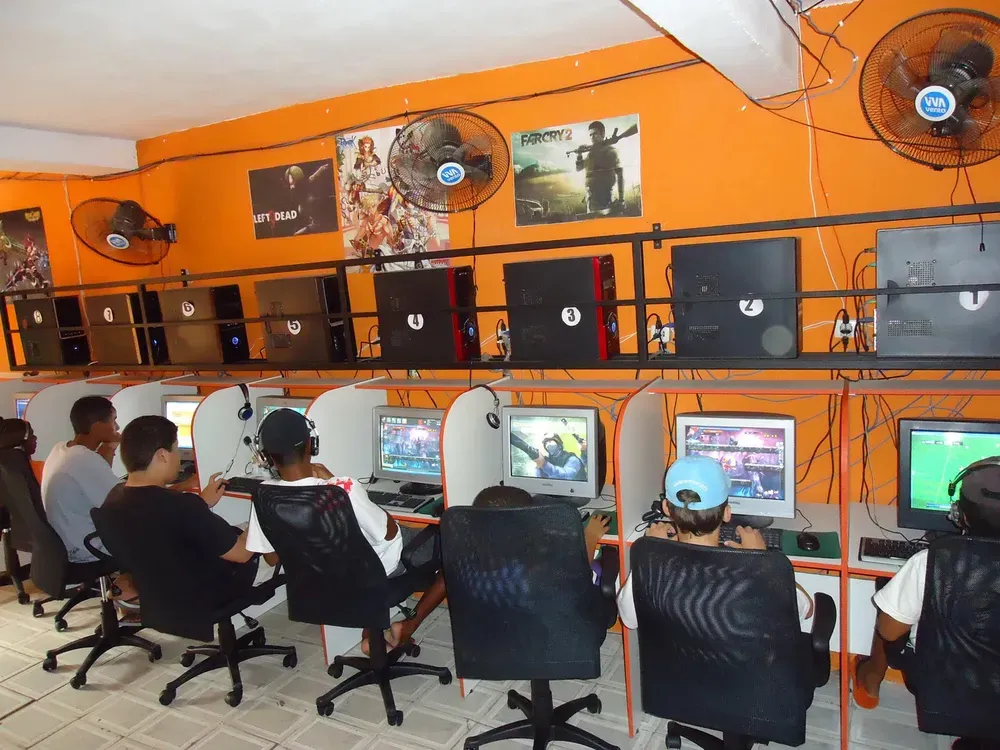
Due to economic conditions and limited access to the Internet and personal computers, Level Up adopted a creative and bold business strategy that created "Ragnarok Mania" in Brazil, paving the way for its next IPs. Listed below are some of the company's initiatives in Brazil:
- The games published by Level Up did not require high-end, expensive computers;
- Four months of free beta testing of its first game, Ragnarök Online;
- Free distribution of DVDs with Ragnarök Online;
- Translated publication (2004–2005) of the manhwa series created by Lee Myung-Jin, Ragnarök (20 volumes, in the Brazilian edition), which inspired the game;
- Partnership with LAN houses spread across the country for events, advertising, and at the point of sale for Level Up products;
- Level Up magazines (which includes the first magazine specialized in online games in Brazil) with credits for online games;
- Advertising of Level Up on a variety of products;
- Free DVDs of Level Up's games in breakfast cereal boxes (something widely consumed by children and teenagers from middle-class families in Brazil at that time);
- TV advertisements;
- The Portuguese-dubbed anime of Ragnarök Online (2005–2006) aired in Brazil on July 3, 2006, through a partnership with Level Up and Cartoon Network (a channel that was not broadcast on open TV, but which was widely watched by children and teenagers from middle-class families in Brazil);
- Participation in Brasil Game Show (BGS), the largest gaming convention in Latin America and one of the largest in the world;
- Participation in Anime Friends, in São Paulo, the largest anime and Asian pop culture event in Latin America.
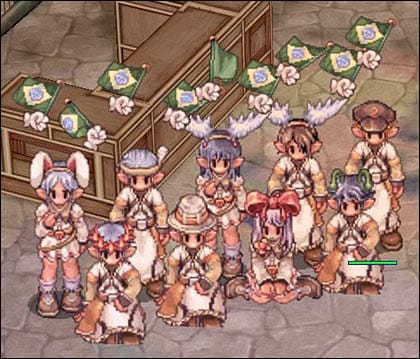
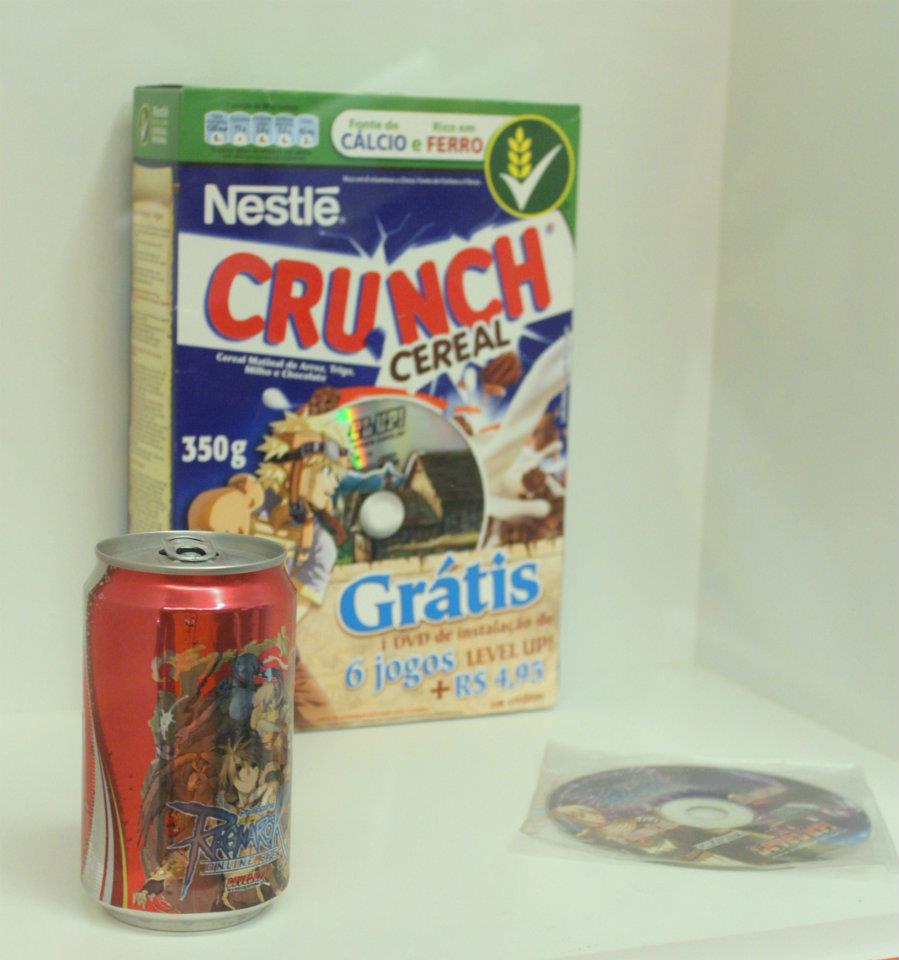

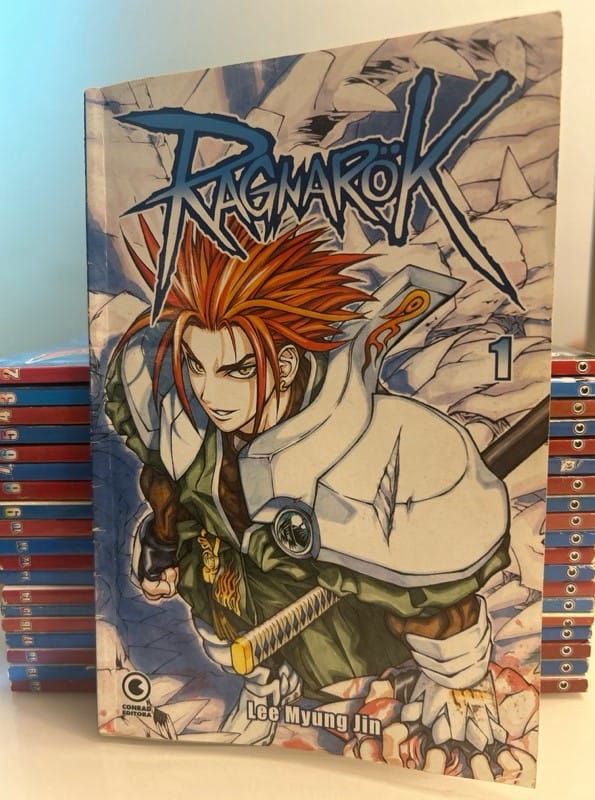
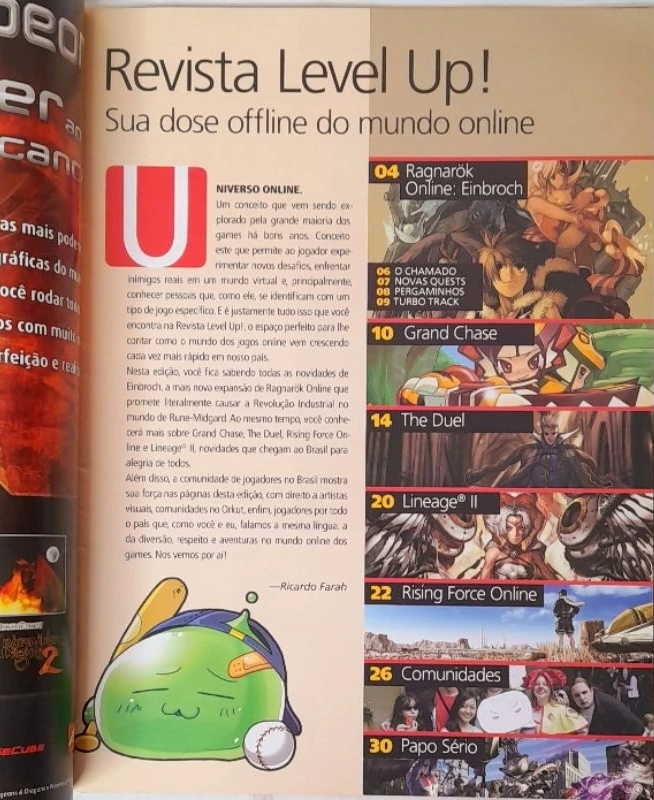
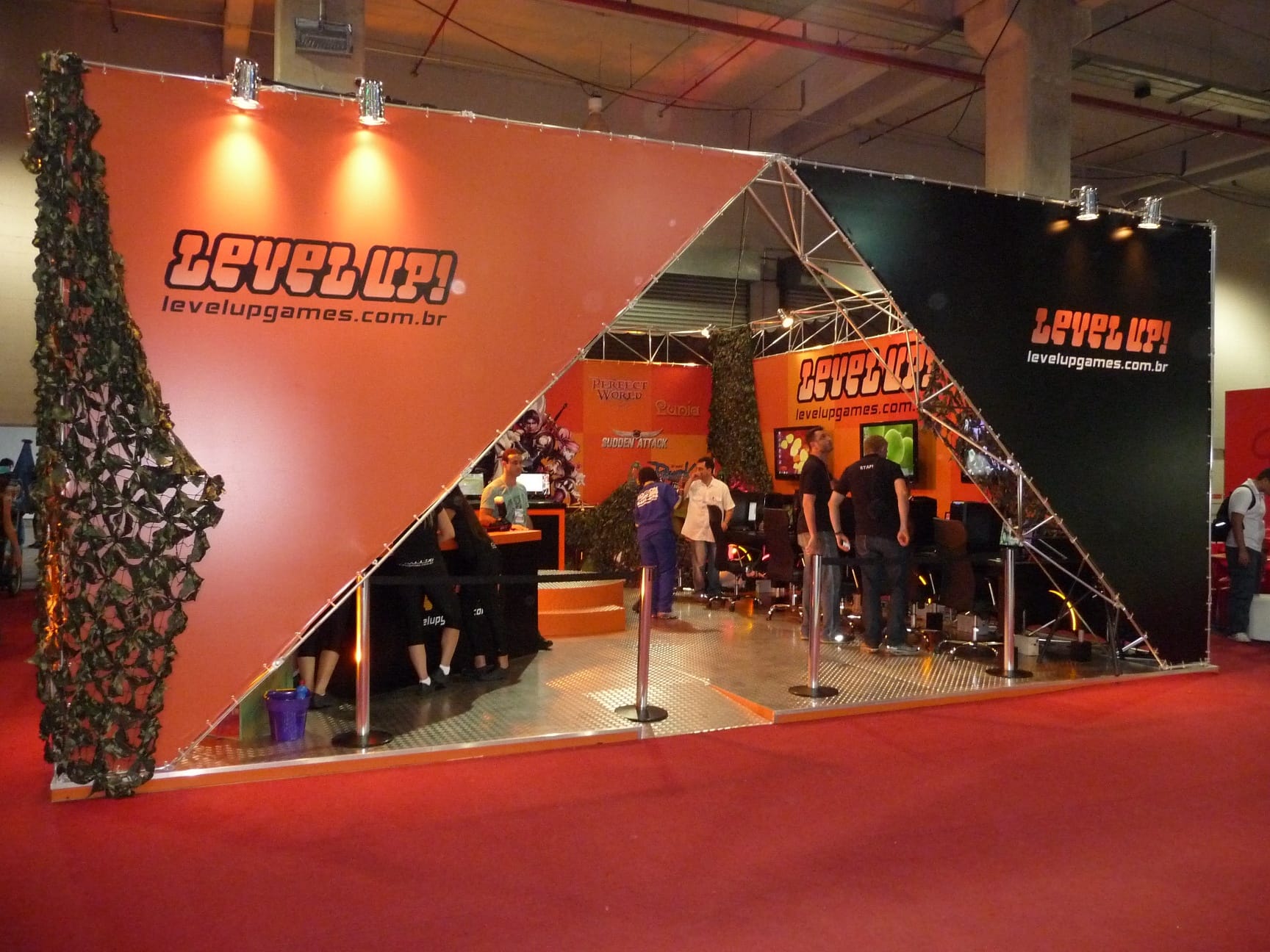
GMs from the beginning of Ragnarök Online in Brazil; Level Up advertisements; Ragnarok: The Animation with Brazilian Portuguese dubbing; collection of the manhwa that inspired the game Ragnarök Online; Level Up! Poster #2 intro page (2006); Level Up at Brasil Game Show 2011. Sources: Forum Ragnarok Online, Facebook (Grandchase), Level Up Latam, Shopee, Ragnarok Online Brasil, Adrenaline.
Below is the official Level Up video presenting Ragnarök Online in Portuguese (unfortunately there is no English translation). It is interesting to note how extremely detailed it is because most Brazilians had no idea what the heck an MMORPG was.
Level Up also made TV commercials for other games besides Ragnarök Online. An example is the many nonsensical TV commercials for MapleStory (something that only makes sense in the 2000s). The only Portuguese sentence in these videos is something like "Do you want to do things from another world? Visit maplestory.com and play for free!".
Videos
- Official presentation of Ragnarök Online: https://www.youtube.com/watch?v=JujNhFKRlR4
- 2010 MapleStory TV commercial: https://youtu.be/T_9Jq-DFf5Y?si=Ijfr-NJ6VD2bvBd6
- Anime Friends 2011 - Ragnarök Day: https://www.youtube.com/embed/0tXFv4816H4?si=rAm9yGBD-z1H_YsQ
- Anime Friends 2011 - Grand Chase Day: https://www.youtube.com/embed/1_DPKCpfyFc?si=cSe_J2qcDPxYoAt9

In February 2005, Level Up officially entered the Brazilian market, launching its first MMORPG in the country, Ragnarök Online (after 4 months of beta testing, 2004–2005), the first Korean online game to be successfully exported to other countries. In Brazil, it was the first MMORPG officially translated into Portuguese, running on national servers, with a payment system in Real (Brazilian currency since 1994).
Throughout its history in the country, the game has had free and paid official servers, with a microtransaction system for free servers and a VIP server system. Premium access for RuneScape and FunOrb, VIP access and ROPs for Ragnarök Online, moedas ("coins") for Khan War, gemas ("gems") for Smite, APs for Assault Fire and CASH for many online games (including Allods Online, Combat Arms, Elsword, Forsaken, Grand Chase, M.A.R.S., Sudden Attack, and Warface) could be obtained not only on the website, but also by purchasing Level Up magazines.





Cover and some pages of Level Up! Poster #20 (2010). This anniversary edition includes an interview with Grand Chase voice actors and behind-the-scenes from the Level Up editorial team. Source: Mercado Livre.
This was a brilliant marketing strategy for children. This way, instead of needing their parents' credit cards, children simply had to ask to buy a magazine, something much more normal and acceptable to their parents. This strategy encouraged the purchase of magazines with entertainment, art, and information about Level Up games. This method was applied not only to Level Up! Poster magazine, but also to other Level Up products, such as Level Up! Quadrinhos ("Level Up! Comics"). The first issue of Level Up! Poster magazine was published in 2006, and new issues were published for many years after. In 2016, a special 10th anniversary issue of Level Up! Poster #100 was published. Level Up! Quadrinhos magazine had its first volume published in June 2011 and its last issue in June 2016.
After Ragnarök Online ended its beta testing period, many Brazilians could not afford to continue playing it; in the case of children and teenagers, many could not convince their parents to pay monthly for it, as it was a new business model that was not yet widely accepted by Brazilians. However, the game delighted so many players that many accepted Level Up's credit system and continued to play Ragnarök Online. Over the years, other Level Up games were also published (many of which were free-to-play with microtransactions), engulfing practically the entire potential MMORPG audience in the country.
The main highlights during the 2000s were Ragnarök Online and Grand Chase. Despite all the economic and internet access limitations in the 2000s, these two games independently achieved the national record for simultaneous online players of 21,000 players. This record was broken in 2010 by another MMORPG published by Level Up, Perfect World, with 22,331 simultaneous players. However, Perfect World's record was short-lived: in 2011, Grand Chase reached the impressive milestone of over 39,500 simultaneous players in Brazil.









Pages from Level Up! Comics #31 and #32. In the center of the image gallery is the cover of #32, published in January 2014. Source: Grand Chase Wiki.
It may be hard to comprehend the impact of these games today when we have constant access to the internet. But if you’re not impressed by these numbers, in addition to all the economic and internet access limitations discussed above, consider that about 90% of the 5,565 Brazilian cities at the time had fewer than 40,000 inhabitants. In other words, the number of simultaneous Grand Chase players in Brazil was roughly equivalent to the population of one of the largest cities in the country. It's worth noting only a small fraction of Brazilian households had a reasonable internet connection to play an MMORPG in 2010, and 65% of households did not even have a computer!
We can speculate about why a game like Grand Chase was so successful in Brazil. Grand Chase is essentially a fighting game with RPG elements, and fighting games were among the favorites of Brazilians in the 1990s and early 2000s. But unlike most fighting games of that time, Grand Chase's graphics were adorable for girls too (similarly, Ragnarök Online's graphics were appreciated by both girls and boys). This game is simpler for new players, compared to Ragnarök Online, and at the same time, it is a complex game for those dedicated to competitive multiplayer. Grand Chase was also more economically accessible to Brazilians, and the Portuguese dubbing made the characters more captivating and memorable. The voice actors of Grand Chase are fondly remembered to this day throughout the country; some are even invited to participate in yearly gaming and Asian pop culture events.
Grand Chase voice acting in Brazilian Portuguese
- Classic Voice Acting: https://www.youtube.com/embed/wv2aFLgVJJA?si=nvhv2WPIFFF22G8L
- New voice acting (with the same voice actors): https://www.youtube.com/embed/15VLPWwxz9s?si=drT6gTOqI7NuQWgP
Although Grand Chase is a Korean game, it is more popular in Brazil than anywhere else in the world. Ragnarök Online is a similar case: it was popular internationally, but in Brazil, it found success of an unusual magnitude, with an impact probably even greater than that of Grand Chase, although less visible, since it was also widely played on pirate servers. It is important to note that these games were not Level Up's only successful ones: Perfect World and MapleStory, among others, enjoyed large Brazilian audiences, and many still play them to this day. However, Level Up had to compete with Blizzard's titans and other MMORPGs in the 2010s. As Level Up's MMORPGs became less popular in Brazil, World of Warcraft gained popularity.
As a tribute to Brazil in the 2000s, the developers of Ragnarök Online created a region in the game entirely inspired by Brazilian culture. After the failure of Erinia, this region (which includes a dungeon and a city called Brasilis) is perhaps the closest we've seen to a successful MMORPG based on Brazilian folklore.

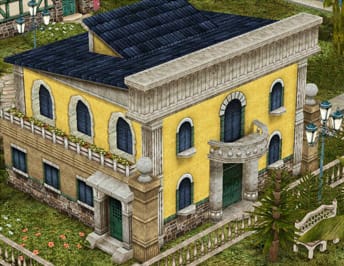
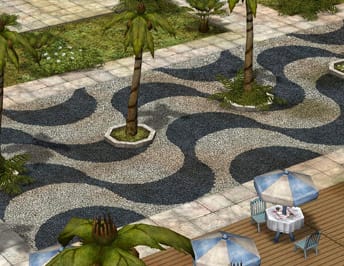
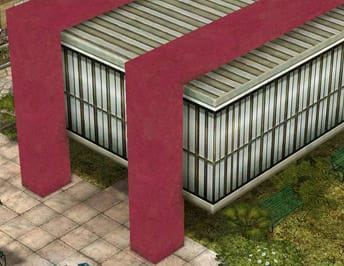
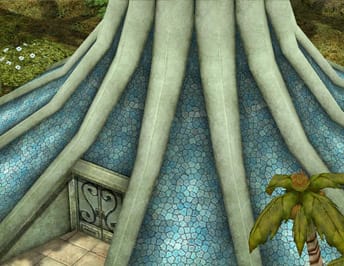
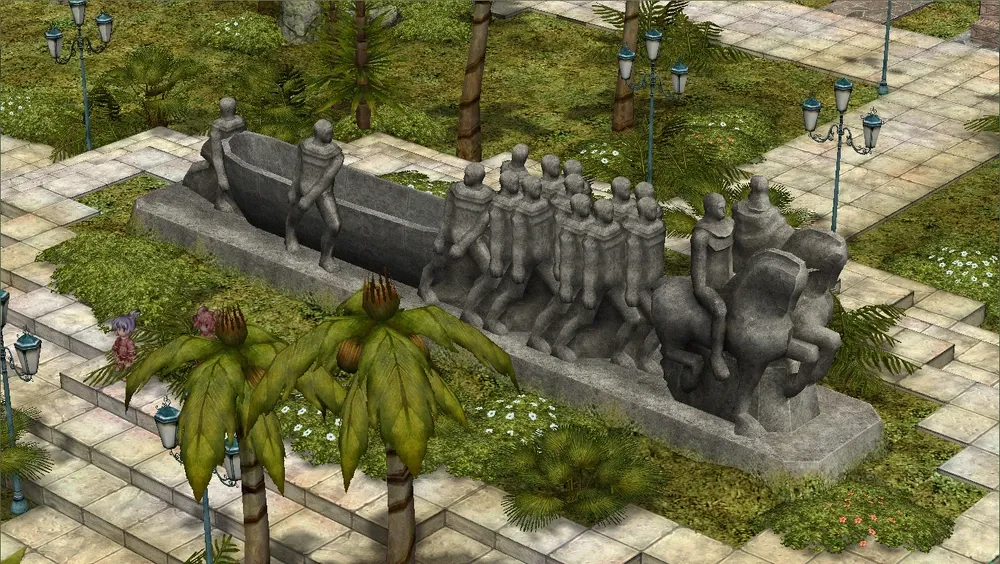
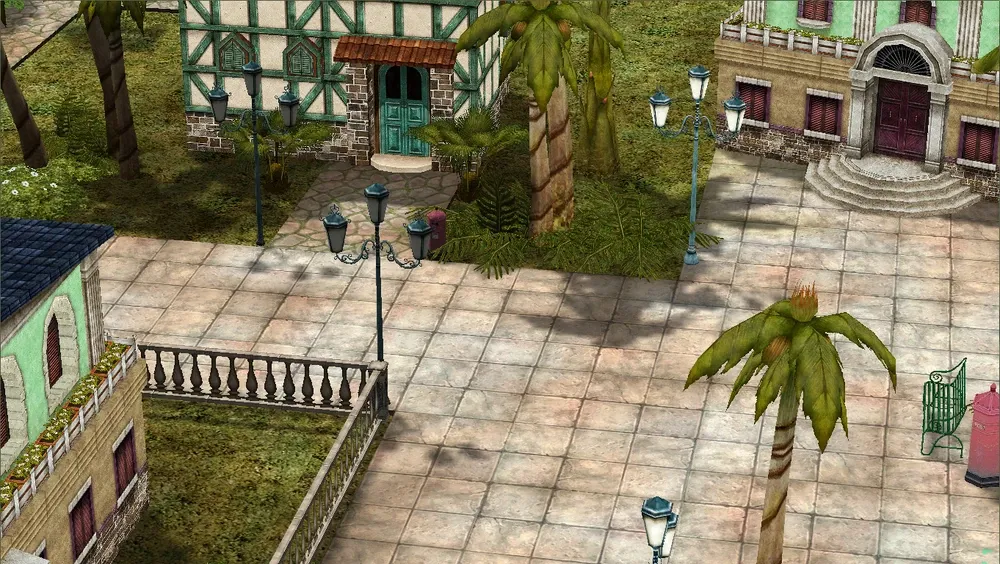
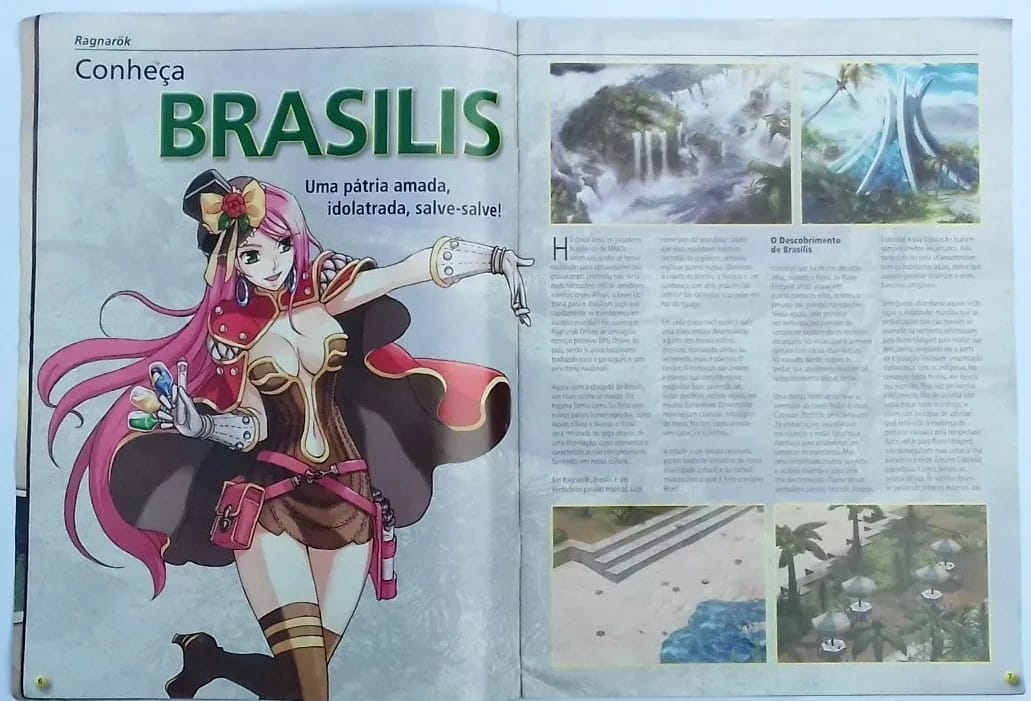
From top to bottom and from left to right: the monsters of the Brasilis region inspired by Brazilian fauna and folklore (from left to right: Boitatá (boss), Headless Mule, Toucan, Curupira, Iara, Jaguar and Piranha); colonial house in baroque style; "Copacabana Beach Boardwalk" in Brasilis; Brasilis Art Museum; Cathedral designed by "Nascar Omeyer" - a reference to the Brazilian architect Oscar Niemayer; the Verass Monument in the center of town; a screenshot showing elements of the tropical island city; Brasilis in the official Level Up magazine #17 (2009). Source: Level Up.
Naturally, the developers didn't forget to add samba instruments to the soundtrack (check out the video below). I found a video of a French gamer on YouTube from when this region appeared in Ragnarök Online 15 years ago. He seems to have loved the city (and also football, the beach, and Brazilian women, as I would expect).
Brazilian fans of Grand Chase also received a beautiful tribute from Level Up: a farewell concert when the game was discontinued in 2015. You can watch the full concert in the playlist below:
II. Game design and online experience in Level Up games
Having discussed the social and economic context and the reception of Level Up's games in Brazil, we can finally analyze some of the games published by Level Up. However, our analysis will have to be somewhat superficial, as it is impossible to detail all of Level Up's games, especially since I have never played many of them and some have unfortunately been discontinued. The first subsection will be dedicated to analyzing general aspects of the MMORPG experience of the 2000s, and in the subsequent subsection, I will briefly comment on my favorite Level Up games.
Classic MMORPG game design
An MMORPG (Massively Multiplayer Online Role-Playing Game) is a type of online RPG that allows thousands or even millions of players to participate simultaneously, offering a dynamic and interactive virtual world. In this type of game, players interact with the environment, other players, and NPCs in real-time, and the game world continues to function even when the player is not online. If you play any MMORPG nowadays, you have a general idea of what MMORPGs were like in the 2000s. After all, I believe that MMORPGs are still more about their communities than about their scripted adventures. There are some exceptions, such as Final Fantasy XIV, which can easily be appreciated for its main quests, but even in this case, the community is an important consideration in its game design.
MMORPGs are games whose design is thought to provide a space of possibilities not only to follow a plot and evolve a character as in a conventional RPG but above all to freely explore a world with other players. This world has its fictional economy, organic and dynamic, with inflation, demand, supply, service, and many other elements of what exists in the real economy of a country.
However, many classic elements are practically extinct in today's MMORPGs. In Ragnarök Online, the main update for the transition from a classic to a modern style of MMORPG design was the 2010 Renewal update. Subsequent updates have increasingly modernized the game to current MMORPG market standards.
Modern MMORPGs have become much easier and more practical for players. For example, in classic MMORPGs you have to search in different cities for the item you want to buy, comparing prices and eventually trading with other players. Nowadays in games like Final Fantasy XIV, you have an algorithm that lists all the items that are being sold by other players, and you can simply select the cheapest one for purchase. These and other design choices have made MMORPGs more convenient, but they have also weakened the "value" of certain achievements and immersion in a virtual society. Below are some of the characteristics of classic MMORPGs such as Ragnarök Online, Silkroad Online, Perfect World, and many others published by Level Up:
- Dying can be costly (you lose a significant amount of experience);
- It takes a long time to gain the experience to evolve your character, especially at a high level;
- It is very important to have friends to share items and information with;
- The higher your character's level, the more you depend on parties and guilds to progress in the game;
- Transportation and teleportation are not automated, and can be costly;
- It is common to need help from other people to get through a dangerous region and reach an important place;
- High level of emergent gameplay;
- The bosses were very powerful, some could only be faced by well-organized parties or even a guild;
- It is common that even in introductory areas of the game there were a few powerful (and sometimes offensive) creatures that newbies needed to run away from, and veterans hunted to obtain their rare items;
- Social skills are mandatory to find your way around the game world (it is also common to need to ask for information about where to go and what to do in quests);
- Decisions about your build (distribution of attribute and skill points) are extremely important, as they could make your character unbalanced and terrible, to the point where it would be better to start over with a new character;
- In many places in the game world, it is almost impossible to survive alone, regardless of your class;
- There are many extremely rare items (sometimes with a lower chance of dropping than someone winning the lottery);
- Trying to improve equipment with a blacksmith is increasingly risky (you could lose it forever!);
- Developers and GMs used to have difficulty dealing with bots and hacking.
Another interesting feature of classic MMORPGs that I particularly love is the fact that each player usually has a main character with a single class. After all, a character can typically have just one class, and it is difficult to evolve more than one character at the same time, which costs a lot of time and money. This type of game design choice often means that the avatar's class is linked to the player's personality, as each class has specific functions in parties and guilds. In other words, choosing to be a hunter, knight, wizard, priest or bard decisively influences your experience in the game forever.
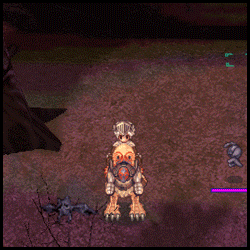
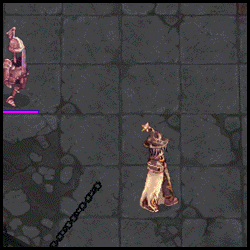
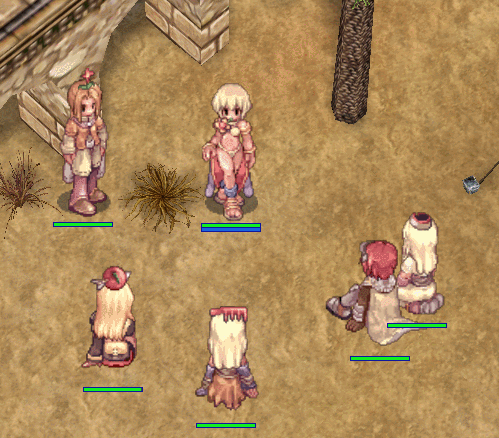
From left to right (Ragnarök Online): a knight; a wizard; a bard and an odalisque playing music for the party members. Source: Divine Pride forum.
My top 5 online games published by Level Up
I would like to briefly comment on some of Level Up's games individually. The following five numbered games are my favorites from Level Up, all of which are still playable today, and are good examples of the variety of online games from Level Up in the 2000s.
Ragnarök Online



Form left to right: a swordsman and three rockers; Prontera, the capital and the center of the economy of Rune Midgard; the War of Emperium. Source: Warp Portal BR, The Enemy.
In the early 2000s, 3D MMORPGs were widely praised for their immersive settings, but 2D MMORPGs tended to have more charismatic character designs. Ragnarök Online combined the advantages of both design styles into an MMORPG with 3D settings and stylish 2D characters; not only were the avatars well-designed, but the creatures also had charismatic and creative sprites. Monsters like the Rocker (a violin-playing grasshopper) are unforgettable. Ragnarök Online's soundtrack is equally memorable; for many Brazilians (including me), the Prontera theme and Wanna be Free (the War of Emperium event song) are some of the most iconic pieces of RPG music ever. The tracks below, from the Ragnarök Online soundtrack, are more memorable in Brazil than many internationally celebrated Final Fantasy songs.
Even before the first issue of Level Up! Poster magazine was published, Ragnarök Online was more than popular in Brazil, it was a revolution. The Heritage update (which introduced trans-classes - another stage of character development) motivated many players to buy the first issue of the magazine. What particularly enchanted me about the game was the way it seemed like such a real society but in a fantasy world. I made friends in this game that lasted for years, and there are events, scenarios, music, creatures, and battles that I remember with clear detail. I know no other world in an RPG as well as Rune Midgard, because in this world you had to interpret the quests, NPCs, maps, and the architecture of the places by yourself.
This type of exploration made me get to know Rune Midgard the same way I get to know a new city in the real world: saving money, asking other players, and sometimes exploring on my own, walking carefully from one region to another. The items I found could be valuable or not, nothing told me about this a priori, I had to negotiate personally or check the price that other players set for that item in the cities; the price of an item could change a lot depending on the season and events. Typically, I had a priest, wizard, or hunter as my main class, but I also liked to have a second character (as a blacksmith or alchemist) to provide services to the economy of Rune Midgard, such as making potions and custom weapons (improved or imbued with elemental powers).
In addition to the individual immersion, Ragnarök Online provided a collective experience of Rune Midgard. I and other players not only made our stories, but together we lived the history of the world; sometimes new lands were discovered, such as islands and entire hidden regions introduced in new updates; new quests and monsters appeared, and every week we prepared for the famous War of Emperium, where guilds compete for the castles dotting the game map. A castle gave guild members benefits, such as an exclusive dungeon and access to some NPCs inside the castle. It's interesting how the game design was intrinsically designed for this war since guilds evolve as characters, and guild leaders have specific skills to be used in war. As a bonus, the lords of the castles were known by everyone on the server for their banners in the cities.
Ragnarök Online is a legendary game in Brazil, and Level Up is unlikely to discontinue it anytime soon.
Silkroad Online


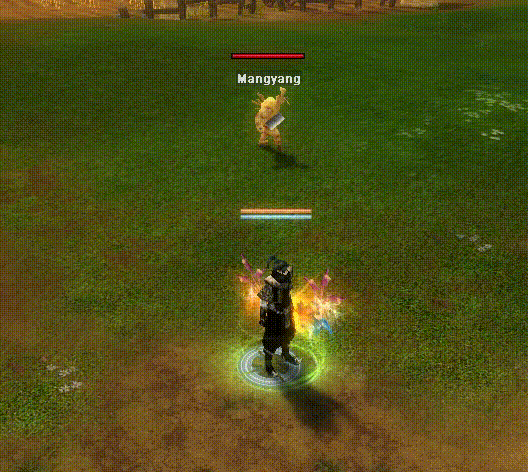
From left to right (Silkroad Online): a thief; a delivery quest (trading between cities) with four merchants and four hunters (and two thieves can be seen in the background on the left); an archer killing the weakest monster in the game. Sources: Soft32, playorigin, vsro.org.
While Ragnarök Online introduced me to Norse mythology with its 2.5D design, Silkroad Online introduced me to Far Eastern mythology and Asian aesthetics with its 3D design. Silkroad Online shares many of the characteristics of classic MMORPGs with Ragnarök Online, but in Silkroad Online it is easier to fight alone against other monsters (rarely does anyone have a 100% support build), and characters are not defined exactly by classes, but rather by the weapons they specialize in (such as bow, spear or sword and shield). Interestingly, the game world is more dangerous in relation to other players, as they can propose duels almost anywhere, and in some cases (such as when the player is dressed as a thief) one could be attacked without warning.
The most interesting things about this game are the jobs and the interactions between cities. The player can choose between three jobs: merchant, hunter or thief. Merchants can do quests to deliver supplies from one city to another; hunters fight thieves and protect merchants; thieves rob merchant caravans. I used to play as a merchant, and I loved traveling between cities with different types of caravans (some could carry more weight than others, and also varied in speed and resistance). Delivery quests involve route strategy; sometimes it's better to be on the roads, where there are fewer monsters, other times it's better to fight monsters and avoid encountering other thieves, and you may want to hire a hunter friend if your merchandise is valuable.
Silkroad Online is currently published internationally by Joymax.
Dofus

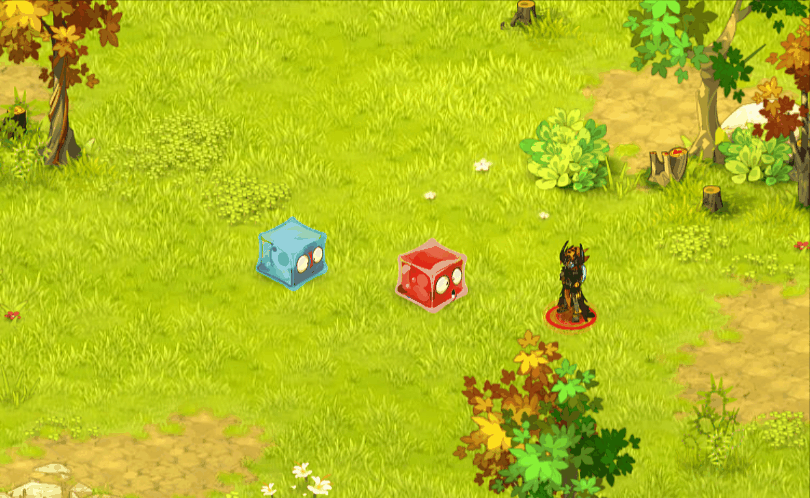
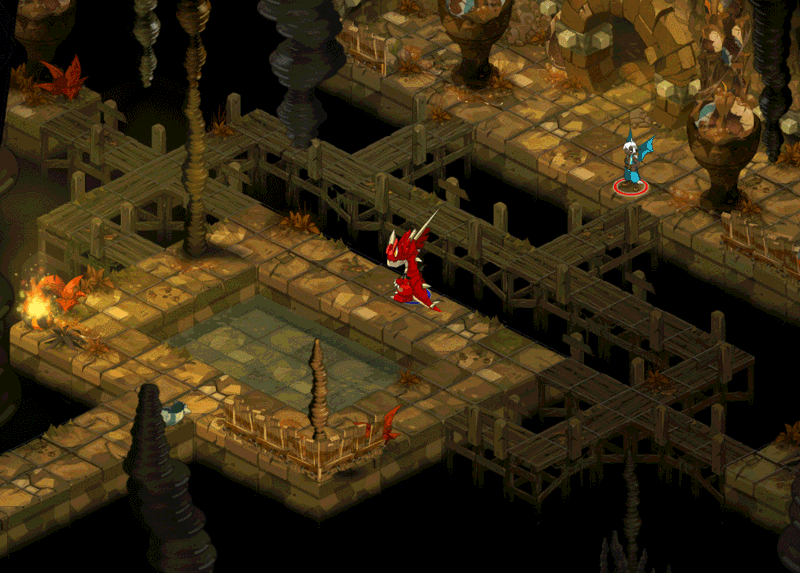
From left to right (Dofus): city design; a non-offensive tactical skill; a long-range offensive skill. Source: Dofus.com (forum).
Tactical RPGs are my favorite subgenre of RPGs; if you also like this genre, you should try Dofus. This is one of the few non-Asian games published by Level Up in the 2000s when there were two servers for Brazil/Portugal (Spiritia and Helioboros); in 2017 they were unified under the name Crocabulia. Originally made in Adobe Flash, Dofus is a 2D MMOTRPG developed by the French studio Ankama Games and is especially popular in Europe and Brazil. This game has a very charismatic design and creative tactical multiplayer systems. There is a fusion of class and race systems for the creation and evolution of your avatar, and battles often involve teamwork. It is very interesting to cooperate in a tactical multiplayer game, like being in a game of chess in which each player controls a black piece, and everyone teams up (or fights independently) against the white pieces. In addition, it is worth mentioning that there are a lot of events and things to do in the cities.
If I had to recommend one of my top 5 MMORPGs to play today, it would be Dofus. The game is currently published by Ankama Games, and I like it even more today than I did back then. If you play on mobile platforms, I recommend DOFUS Touch.
Grand Chase
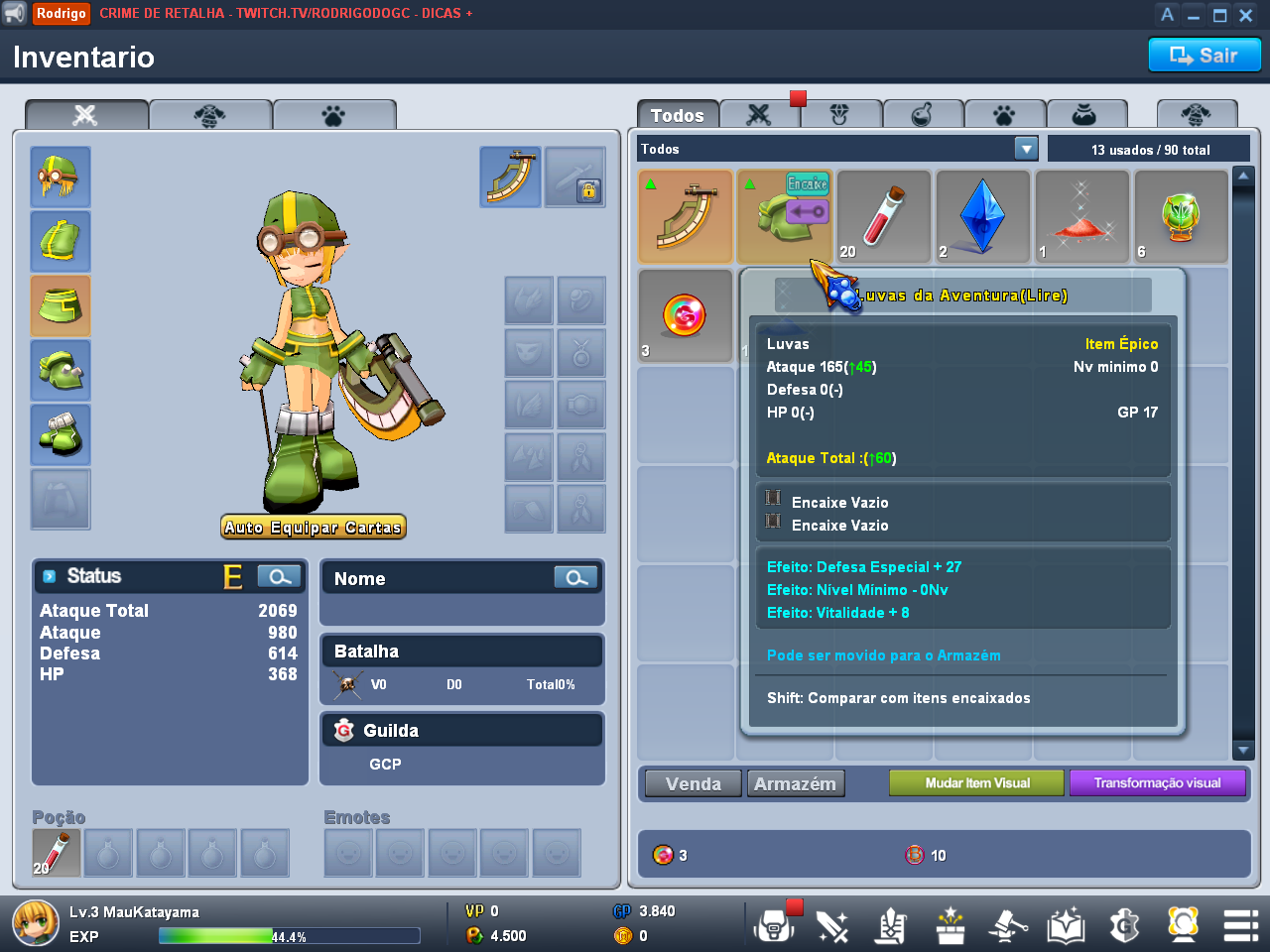

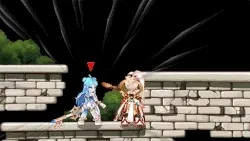
From left to right (Grand Chase): inventory system; a cooperative online multiplayer battle against monsters; Ai using a skill in PVP. Sources: Game Blast, TechTudo, Grand Chase Wiki.
Grand Chase is a 2D side-scrolling action MMORPG. It was Level Up's second most popular game in the 2000s and became their flagship game in the 2010s. Like Ragnarök Online, this is one of the most popular games in Brazil's history. Grand Chase is visually the opposite of Ragnarok Online, with a 2D side-scrolling scenario and 3D characters; both games are equally charismatic, though Grand Chase is cuter and has more customization appeal.
In addition to equipment customization, each character has unique skills and a linear evolution. It is common for players to specialize in certain characters, just like in fighting games. My favorite is Ryan, "the protector of the forest", one of the characters introduced in the first updates. There are different game modes: One of which involves facing monsters and finding items, another enables you to fight against other players. In addition, there is the Practice Mode, in which the player can practice with all kinds of characters and classes.
Although it was discontinued in 2015, the game returned in 2021 (it is available on Steam), and I recommend it to those players who enjoy fighting as much as they do RPGs. It is worth noting that it only has voice acting in Korean, English, and Brazilian Portuguese.
GunZ: The Duel

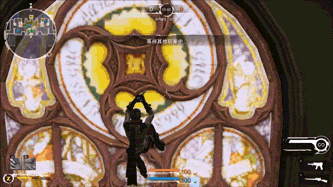
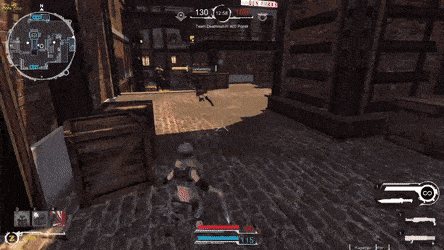
Left: GunZ: The Duel (2003); right (gifs): GunZ 2: The Second Duel (2014). Sources: Games-popularity.com, Steam Community, Genius.
GunZ: The Duel was one of the first games published by Level Up, and was featured in Level Up! Poster #1. Both GunZ games (GunZ: The Duel and GunZ 2: The Second Duel) are online third-person shooters with RPG elements and over-the-top performances (inspired by action movies and anime), including wall-walking and blocking bullets with swords, which is very nostalgic for the 2000s. GunZ: The Duel may not be as charmingly unique and immersive as the others in my top 5, but it is genuinely one of the most fun. In addition to the expected PVP modes, there's also a Quest mode, in which a group of players goes through different stages and fights creatures. I remember that, unlike Grand Chase (in which I preferred cooperative gameplay), I preferred GunZ's PVP mode. One aspect I like about this game is its 3D platform game design; there are maps where you need to climb walls or jump to specific locations and the level design works especially well with verticality.
GunZ: The Duel and GunZ 2: The Second Duel are available on Steam.
My top 5 includes Level Up's two most popular games in Brazil (Ragnarök Online and Grand Chase) and three games with average popularity (Dofus, GunZ: The Duel, and Silkroad Online). They weren't the only popular games from the publisher though, so the following image gallery features some of Level Up's most memorable games in Brazil, including the third most popular in the 2000s, Perfect World.
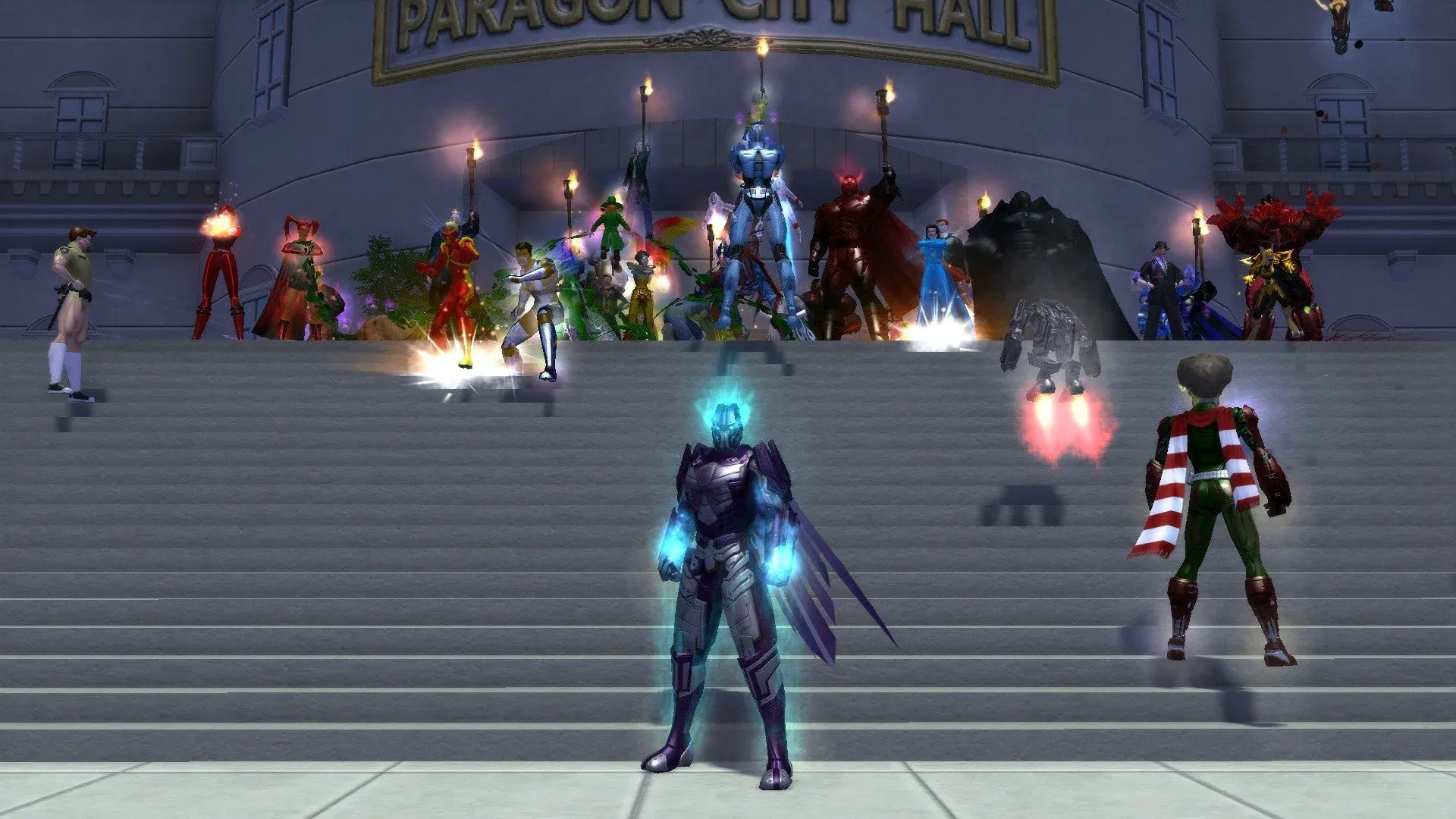
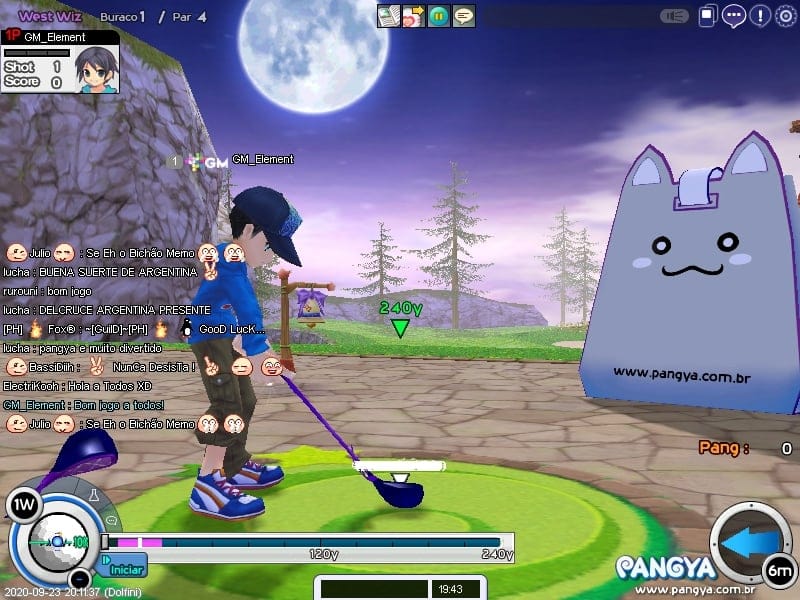
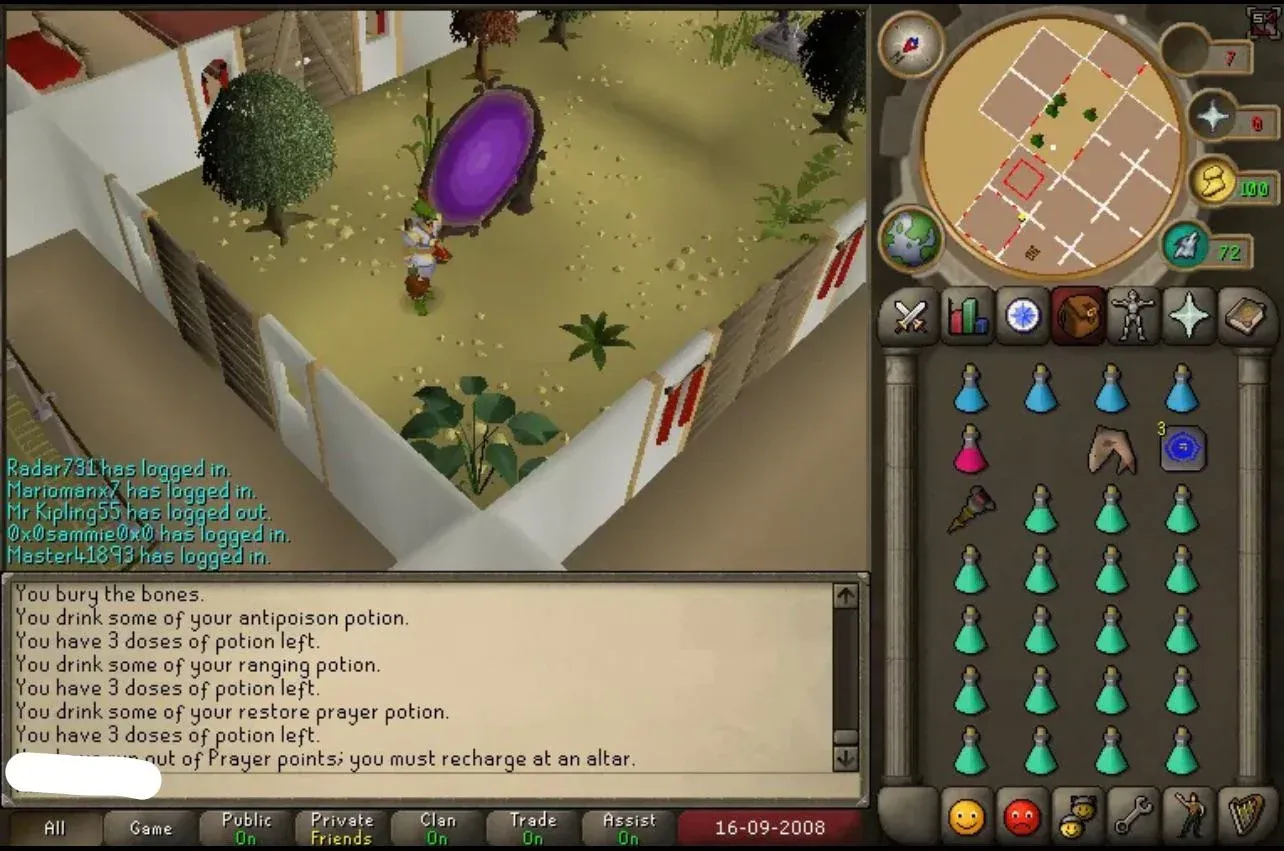
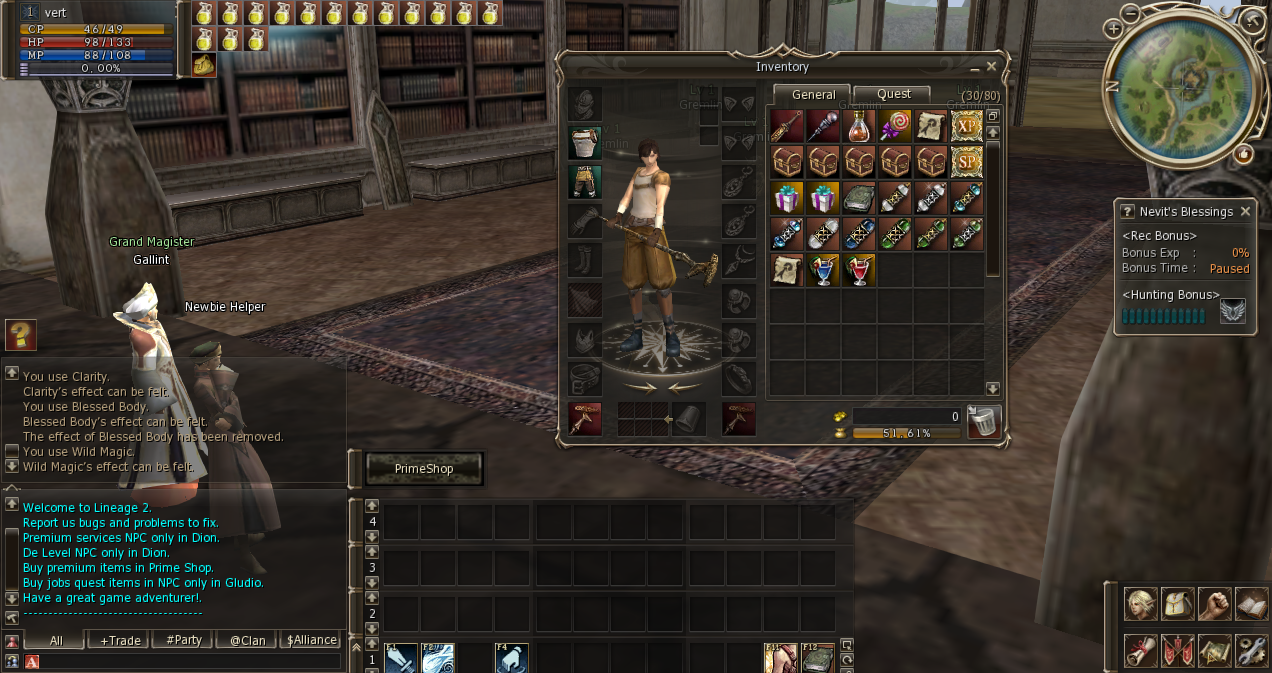
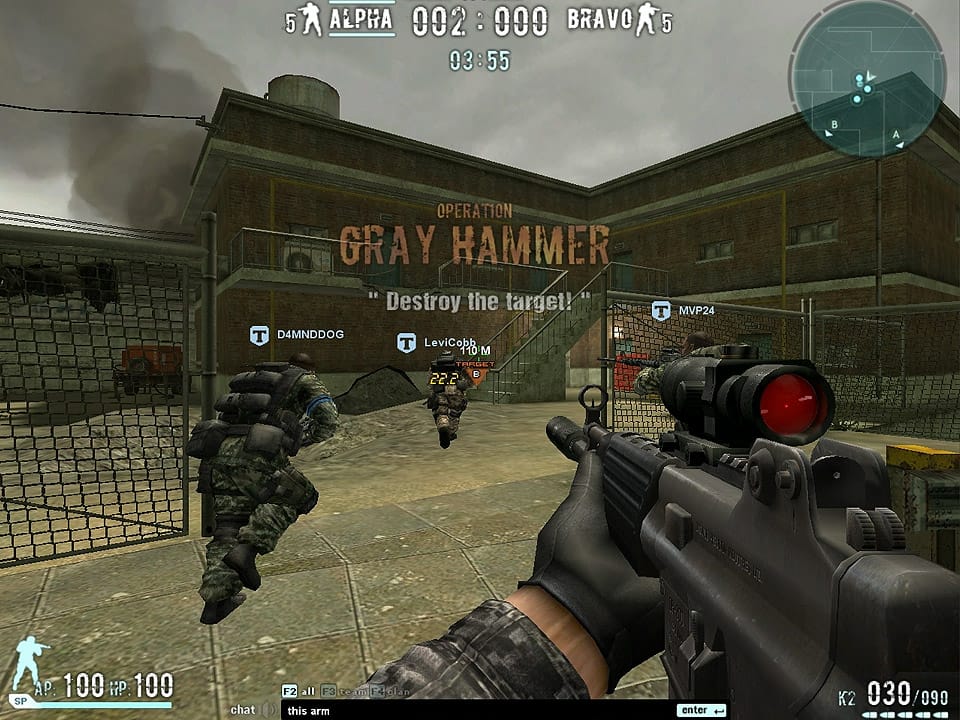
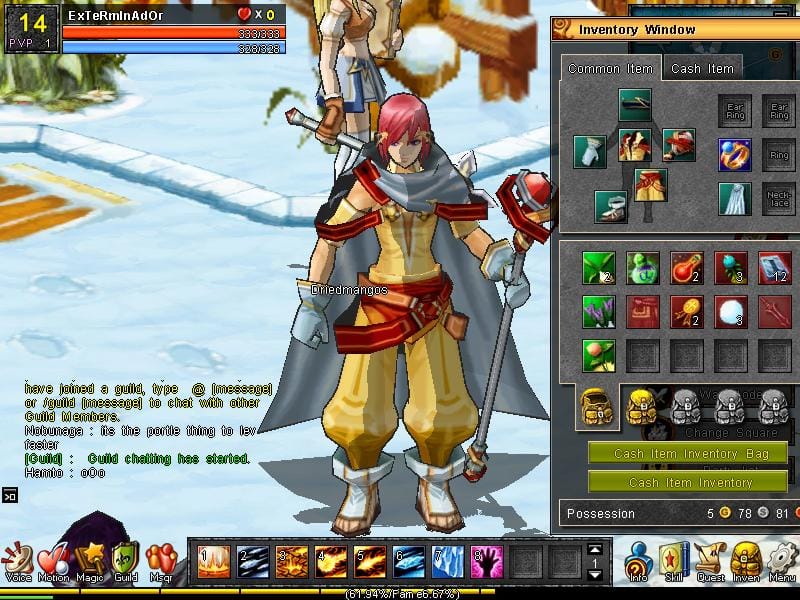
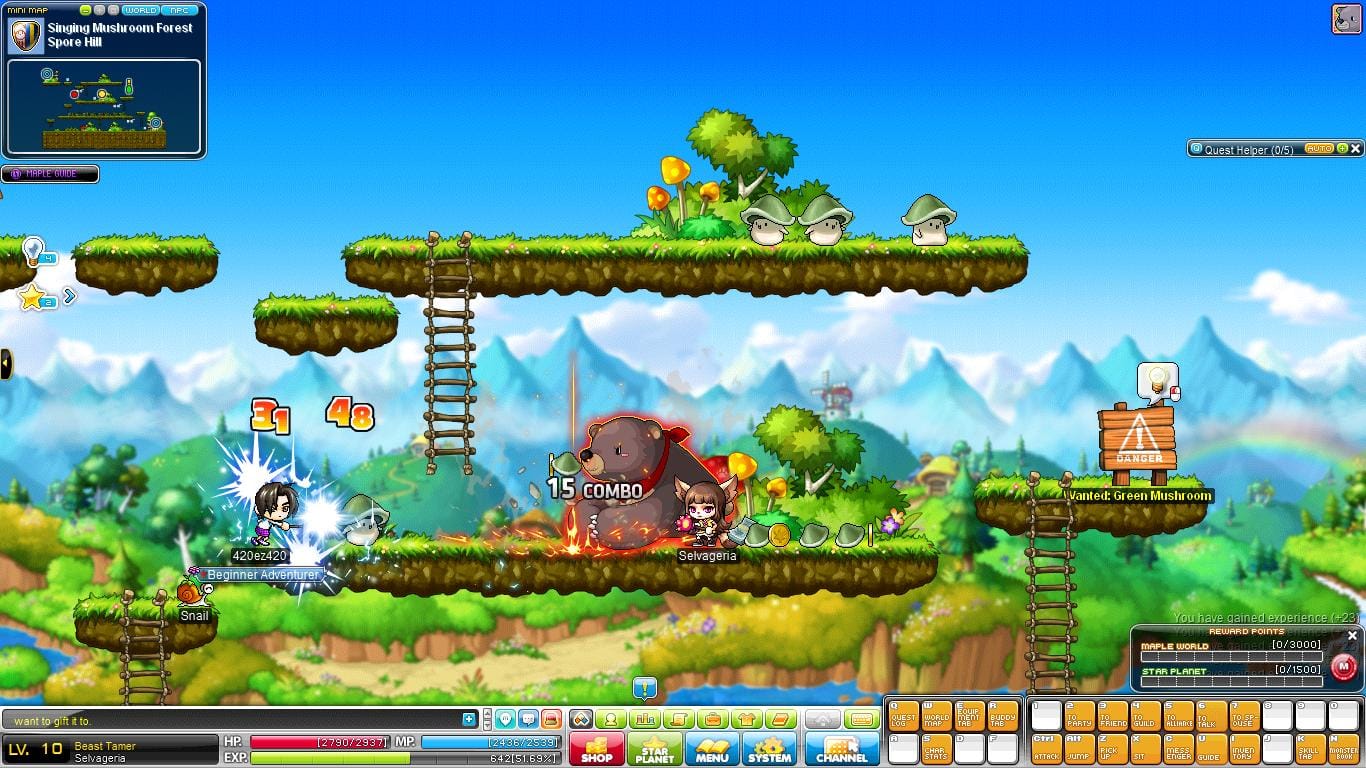
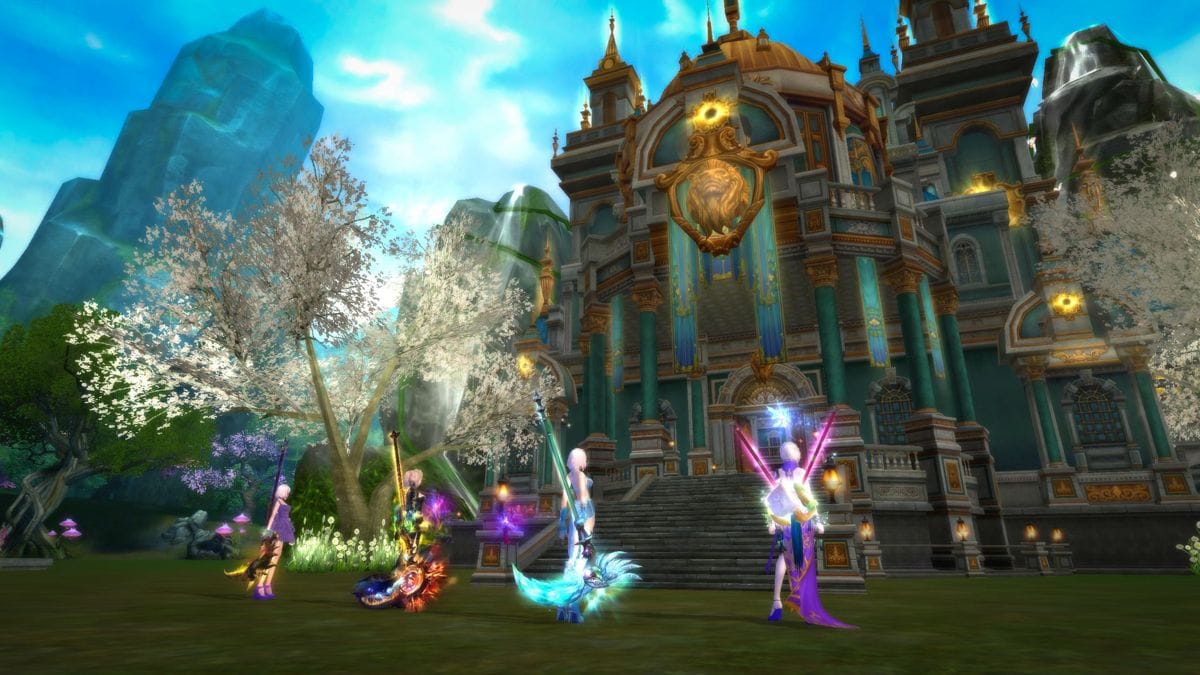
From top to bottom and from left to right: City of Heroes; Pangya; RuneScape; Lineage II; Combat Arms; Lunia; MapleStory; Perfect World. Sources: Facebook, Reddit, l2jbrasil, Adrenaline, level up games fans, The Player Brasil, Mobygames.
III. Final thoughts
Level Up was a key company in the early days of the MMORPG market in Brazil, contributing significantly to mainstreaming Asian pop culture beyond Japan. Today, the experience of playing an MMORPG has changed a lot but still consists of living in a world that is incorporated into our real world. No matter how different the gaming market is in Brazil, the influence of our history cannot be underestimated.
More than 20 years after Level Up arrived in Brazil, according to a recent survey, today 92.5% of the population has access to the internet (and 34.2% access the internet via computer). According to a survey by PGB 2024, around 74.5% of the Brazilian population plays some kind of electronic game. 58.2% of Brazilian gamers play mainly on PC, 33.2% prefer to play on smartphones or tablets, and 27.7% play on consoles.
Brazilians play a lot on mobile platforms and especially on computers, and there are huge communities of Brazilians in all types of MMORPGs nowadays, including Final Fantasy XIV, myself included. It's amazing to be part of such a huge community that includes subcommunities from several countries. Each Final Fantasy XIV player came from a different background in MMORPGs to decide to be in this game and to choose a main class for their avatar; besides the fact that I'm a Final Fantasy fan, I'm sure I was also influenced by my history in Level Up's MMORPGs.
However, I am concerned that there are an increasing number of free-to-play online games that are ignored by game journalists and even game historians. These games have thousands of untold stories about their players, many of whom are in countries in the Global South. It is not only offline games and famous MMORPGs (such as Final Fantasy XIV and World of Warcraft) that deserve to be analyzed and preserved in the pages of history, nor are they the only ones that influence culture in society. I believe that when you discontinue an online game, you are eliminating not just a fictional world, but a world within the real world.
Furthermore, when you do not tell the stories of these games, you are also eliminating from history the people who played them. Many non-Japanese Asian games and some Brazilian games that I played didn't even receive a review on aggregators like Metacritic and Opencritic. They're also not in the pages of the main RPG books, usually dedicated to JRPGs or WRPGs from the Global North, and some games released in Brazil weren't even mentioned on their release day.
One of my goals here at SUPERJUMP is to talk about the history of video games in my country, and I'm just getting started. For an introduction to video games in Brazil, I recommend "Watch our video history of gaming in Brazil", by Jon Partridge. And, if you are interested in delving deeper into the history of video games in the Global South, be sure to check out these books.



Books about video games in the Global South. Source: Amazon.
